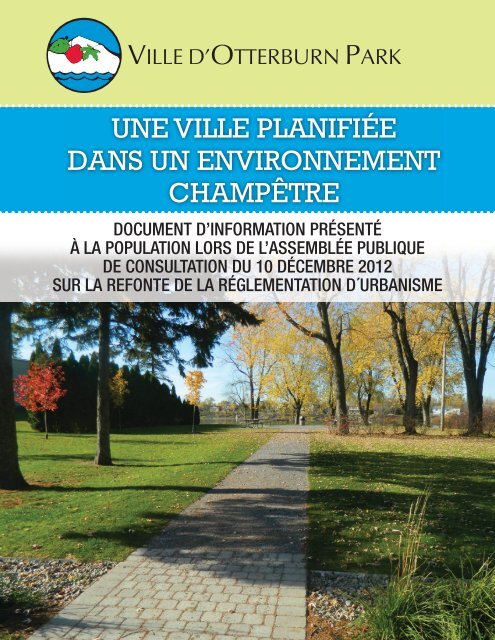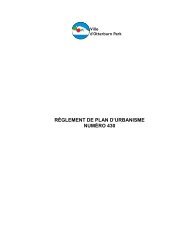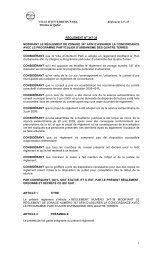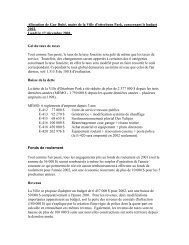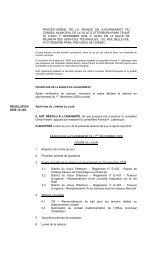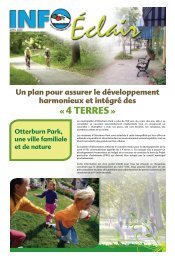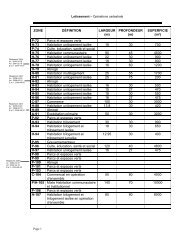Brochure - Ville de Otterburn Park
Brochure - Ville de Otterburn Park
Brochure - Ville de Otterburn Park
- No tags were found...
Create successful ePaper yourself
Turn your PDF publications into a flip-book with our unique Google optimized e-Paper software.
MISE EN ŒUVRE PARLA RÉGLEMENTATIONLa réglementation représente l’outil obligatoire et indispensable pourassurer la mise en œuvre <strong>de</strong>s gran<strong>de</strong>s orientations <strong>de</strong> Plan d’urbanismepermettant que les différents usages autorisés (ex. : habitations,commerces, etc.) puissent cohabiter harmonieusement. À cette fin, leterritoire est divisé en zones dont la plupart, dans notre ville, sont à vocationrési<strong>de</strong>ntielle. Également, l’exercice <strong>de</strong> la confection <strong>de</strong>s divers règlementsa permis d’atteindre 4 objectifs principaux :• Se conformer au Schéma d’Aménagement révisé et à la Loi surl’aménagement et l’urbanisme;• mo<strong>de</strong>rniser nos normes <strong>de</strong>venues désuètes tenant compte quecertaines remontent à 20 ans;• Assouplir <strong>de</strong>s normes ne répondant plus aux besoins <strong>de</strong> la populationou en créer d’autres pour s’adapter aux réalités d’aujourd’hui;• Encadrer la réalisation <strong>de</strong> projets répondant aux besoins <strong>de</strong>s gens.4
326 Higher Education Quarterlyprovision. In some cases, its <strong>de</strong>scription as higher education is unclearand disputed.Nevertheless, most sources report around 180,000 stu<strong>de</strong>nts currentlystudying for higher education and higher-level qualifications in collegesof further education. These account for around one in nine or one in10 of the domestic un<strong>de</strong>rgraduate population in England. A smallernumber of further education stu<strong>de</strong>nts – some 115,000 – are enrolled ininstitutions of higher education and represent a tiny fraction of thepopulation of stu<strong>de</strong>nts studying at the further education levels.Beneath the lad<strong>de</strong>r of higher education qualifications, these are thelevels or areas of lower tertiary and upper secondary education thatfurther education colleges provi<strong>de</strong> for young people and adults in alocality or region. In the case of upper secondary education for 16 to 18year-olds – now increasingly viewed as the core work of most colleges –this role is also un<strong>de</strong>rtaken by secondary schools that provi<strong>de</strong> a ‘sixthform’ beyond the compulsory phase (after the age of 16). Secondaryschools and further education colleges are the main environments whereyoung people prepare for higher education, with the colleges supplyingnearly 40 per cent of entrants to full-time un<strong>de</strong>rgraduate education.Outsi<strong>de</strong> the 90 or more sixth form colleges that focus on full-timeaca<strong>de</strong>mic (A-level) qualifications for school leavers, nearly all the other270 or so general further education colleges provi<strong>de</strong> a range of aca<strong>de</strong>mic,vocational and basic education, both part-time and full-time, and typicallycater for stu<strong>de</strong>nts of all ages and from diverse backgrounds. Inrespect of higher education, the qualifying function performed by thesegeneral colleges, and by another 30 specialist establishments, is moreprominent and extensive than the providing function, often markedly so.This is less the situation among the 50 colleges that have sizeableamounts of higher-level work. Most of the remaining colleges have smallpockets of higher education.Like most of the nearly three million stu<strong>de</strong>nts enrolled in furthereducation colleges, those taking higher-level courses in these settingsstudy mainly part-time. The majority of these courses lead to qualificationsbelow the bachelor <strong>de</strong>gree but some colleges have provision at allthe un<strong>de</strong>rgraduate levels, usually in a <strong>de</strong>fined subject or occupationalarea, and a few have postgraduate programmes. Since further educationcolleges do not award their own qualifications, their certificates, diplomasand <strong>de</strong>grees are validated and awar<strong>de</strong>d by individual universities orby national examination bodies, and sometimes by both. In addition,there are courses that lead to a range of qualifications awar<strong>de</strong>d orrecognised by professional bodies.© 2009 The Author. Journal compilation © 2009 Blackwell Publishing Ltd.
Le Règlement <strong>de</strong> lotissementPar son règlement <strong>de</strong> lotissement, une municipalité peut définir les normesainsi que les conditions à respecter lors du découpage et <strong>de</strong> l’i<strong>de</strong>ntification<strong>de</strong>s lots.Le règlement <strong>de</strong> lotissement permet d’organiser et <strong>de</strong> structurer le territoire,notamment en établissant les normes et conditions minimales à rencontrerlors du découpage et <strong>de</strong> l’i<strong>de</strong>ntification d’un lot projeté. Il fixe les paramètresà rencontrer lors d’une opération cadastrale pour qu’il en résulte un lotconstructible. Les paramètres <strong>de</strong> lotissement sont spécifiés pour chaque zone,en référence au Plan <strong>de</strong> zonage. ce règlement contient aussi les critèresminimaux à respecter pour l’aménagement d’une nouvelle rue.À titre d’exemple, notons :• Assurer la conformité au Schéma d’Aménagement révisé, notammentlorsqu’il y a présence d’une ban<strong>de</strong> <strong>de</strong> protection riveraine sur le lot;• L’introduction <strong>de</strong>s normes encadrant l’ouverture <strong>de</strong> nouvelles rues;• La révision et l’ajustement <strong>de</strong>s dimensions minimales <strong>de</strong> lotissement<strong>de</strong>s lots pour toutes les zones.6
Le Règlement <strong>de</strong> constructionLe règlement <strong>de</strong> construction permet à une municipalité d’encadrer le domainedu bâtiment, mais uniquement pour adopter <strong>de</strong>s normes supérieures ou portantsur <strong>de</strong>s bâtiments ou <strong>de</strong>s éléments non visés par le co<strong>de</strong> <strong>de</strong> construction duQuébec. On peut ainsi mieux contrôler la qualité, la durabilité et le caractèresécuritaire d’un bâtiment par la gestion <strong>de</strong>s matériaux autorisés et la façon <strong>de</strong>les assembler.À titre d’exemple, notons :• L’intégration du co<strong>de</strong> national du bâtiment 2005;• La mo<strong>de</strong>rnisation <strong>de</strong>s normes encadrant les clapets <strong>de</strong> retenue;• La mo<strong>de</strong>rnisation <strong>de</strong>s normes encadrant la conception <strong>de</strong>s fondations<strong>de</strong>s bâtiments principaux;• L’intégration <strong>de</strong>s normes minimales prévues au règlement numéro2008-47 <strong>de</strong> la cmm concernant le prétraitement <strong>de</strong>s eaux usées,principe <strong>de</strong> conformité;• L’intégration <strong>de</strong> normes spécifiques visant l’entretien et la salubrité <strong>de</strong>sbâtiments;• La mise à jour <strong>de</strong>s normes prévenant la surcharge du drain <strong>de</strong> fondation.7
Le Règlement sur les projets particuliers<strong>de</strong> construction, <strong>de</strong> modification oud’occupation d’un immeuble (PPCMOI)Le règlement sur les projets particuliers <strong>de</strong> construction, <strong>de</strong> modificationou d’occupation d’un immeuble est rarement utilisé. Il vise à permettre, àcertaines conditions, qu’un projet soit réalisé malgré le fait qu’il déroge àl’un ou l’autre <strong>de</strong>s règlements d’urbanisme <strong>de</strong> la municipalité.Le règlement sur les projets particuliers constitue un outil facilitant la miseen valeur d’emplacements problématiques (ex : reconversion d’immeubles,insertion dans la trame urbaine). Paradoxalement, elle peut servir à autoriserun projet non conforme à la réglementation, mais qui respecte les objectifsdu Plan d’urbanisme sans qu’il soit par ailleurs nécessaire <strong>de</strong> modifier lesnormes d’usage ou d’implantation du règlement <strong>de</strong> zonage, normes qui<strong>de</strong>meurent pertinentes pour le milieu environnant, en autant que le projetapporte une valeur ajoutée au secteur.11
ÉTAPES À VENIRDU PROCESSUSDE MISE EN VIGUEURDE LA REFONTE• Adoption <strong>de</strong>s règlements• Approbation par la mrc• Tenue <strong>de</strong>s registres• Entrée en vigueur<strong>Otterburn</strong> <strong>Park</strong>, le 10 décembre 2012www.ville.otterburnpark.qc.ca12


